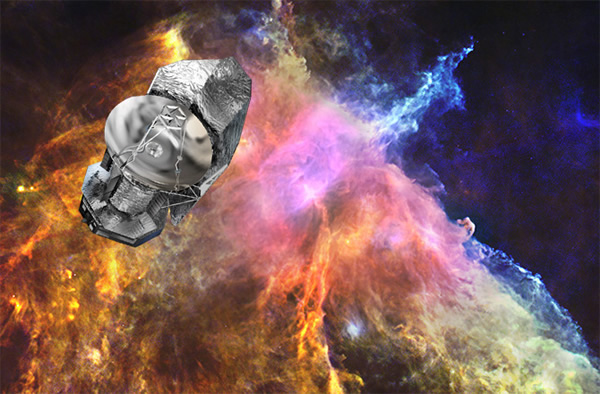Europe's Herschel Space Telescope Officially Dead
Artist's impression of the European Herschel infrared observatory against a backdrop of the Horsehead Nebula, as imaged by the mission.
The Herschel infrared space telescope took its final bow on Monday, climaxing a successful four-year mission to observe the birth of stars and galaxies, the European Space Agency (ESA) said.
Hubble Trouble
In 2008, a glitch in a computer onboard the Hubble Space Telescope caused communication issues.
STScI, NASA
The largest and most powerful infrared telescope in space, Herschel made over 35,000 scientific observations and amassed more than 25,000 hours of science data, it said.
"Herschel has been turned off," ESA director general Jean-Jacques Dordain told journalists at the Paris Air Show.
"It is not a surprise, it was expected, it was scheduled," he added.
Herschel has run out of a supply of liquid helium required to cool its instruments to near absolute zero (minus 273.15 degrees Celsius or minus 459.67 degrees Fahrenheit) in order to make its observations.
"As it heats up it becomes unusable," said Dordain, explaining why the data link with Herschel was shut down at 1225 GMT Monday.
Its mission officially ended on April 29, but the satellite was used in its dying weeks as an "orbiting testbed", said an ESA statement.
"We had a sophisticated spacecraft at our disposal on which we could conduct technical testing and validate techniques, software and the functionality of systems that are going to be reused on future spacecraft," said Herschel's spacecraft operations manager, Micha Schmidt.
"This was a major bonus for us."
The satellite has now been placed in a safe, "disposal" orbit around the Sun.
"The last thruster burn came today, ensuring that all fuel is depleted," said the ESA statement.
BIG PIC: Herschel Spots a Hot Young Star-Forming Butterfly
Launched in May 2009, Herschel carried 2,300 litres of liquid helium coolant, which evaporated over time. Its expected lifetime had been 3.5 years.
At 7.5 meters (24.3 feet) high and four meters wide, Herschel had a launch mass of 3.4 tonnes.
It cost 1.1 billion euros ($1.4 billion), and was named after Sir William Herschel, the German-born British astronomer who discovered Uranus in 1781 and infrared radiation in 1800.
It carried three cameras and spectrometers and a primary mirror 3.5 meters (11.37 feet) across -- able to collect almost 20 times more light than any previous infrared space telescope.
BIG PIC: See the Andromeda Galaxy in a Cool New Light
Its infrared technology allowed Herschel to see galaxies that were previously hidden from scientists' view by cosmic dust clouds.
In 2011, it was reported that Herschel found the first confirmed evidence of oxygen molecules in space.(Jun 17, 2013 05:57 PM ET // by AFP)












